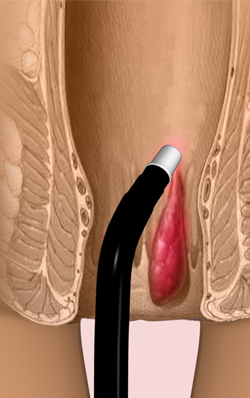
Piles also known as hemorrhoids are quite common; about half of the total world population suffers from piles at least once in their life time. There are vessels located at the lower part of the rectum and anal area which are responsible for controlling stool passage and also protects the inner walls of the anus from friction (cushion like action). In piles these vessels become engorged resulting into several symptoms.
Depending upon the location of the engorged vessels, piles are of two types; internal and external. These two varieties of piles also present with different set of presenting symptoms. Pain and swelling are the most common presenting symptoms in case of external hemorrhoids whereas in case of internal hemorrhoids painless bleeding is the most common presenting symptom.In most of the cases of piles with mild to moderate symptoms life style change like intake of fiber rich diet, plenty of water etc are enough to relieve the bothersome symptoms. However in severe cases mild surgical procedures are required to control the symptoms.
Causes
There are vessel like structures acting as cushions are present around the anal canal. Mainly there are three such structures located at left lateral (left sided), right anterior (front part of the right side) and right posterior (back part of the right side). These vascular structures consist of sinusoids (a type vessel which is neither artery nor vein and unlike the veins lack smooth muscles on the inner part of the wall), connective tissue and smooth muscles. These types of blood vessels are known as hemorrhoidal plexuses.
These vascular structures mainly help in maintenance of continence as these structures provide about 15 to 25% of the pressure required to close the anal orifice and also helps to protect the muscles of the anal sphincter from frictional injury during stool passage. Whenever the pressure within the abdominal cavity is increased there is chance that the anal opening will open involuntarily; hence to maintain the anal closure pressure the hemorrhoidal plexus become engorged. If there is prolonged increase in intraabdominal pressure leading to persistent selling of the vascular structure, there is high chance of inflammation and swelling of the vascular structure leading to piles or hemorrhoids. Common causes of increase in intrabdominal pressure include irregular bowel habits, habit of sitting in the toilet for prolonged period, obesity, pregnancy, anal intercourse, intake of low fiber diet etc.
Hemorrhoids are of two types depending upon their location; when the hemorrhoids are located above the dentate line (this line divides the anal canal into upper 2/3rd and lower 1/3rd with several anatomical, embryological, structural and other differences), they are known as internal hemorrhoids and those below the line are known as external hemorrhoids.Internal hemorrhoids can be further graded into four grades (I to IV) based upon specific criteria. Internal hemorrhoids are covered by a specific type of cellular lining, the columnar epithelium. This lining lacks the pain receptor hence this type of hemorrhoids are painless. In contrast to it, the external hemorrhoids are covered by the skin and by the anoderm, as both of these structures are pain sensitive external hemorrhoids are painful.
Treatment
In many patients of hemorrhoids only life style changes are sufficient to relieve the symptoms of hemorrhoids. For hemorrhoids having mild degree of symptoms drugs are prescribed. These drugs are usually given in the form of cream, lotion, ointments etc. Hydrocortisone is commonly used to relieve pain and the itching sensation.Minimally invasive procedures are recommended in cases with moderate to severe symptoms.
These procedures are
1) Rubber band ligation: in this procedure one to two rubber bands are placed at the base of the hemorrhoids and kept there. As the blood supply to the hemorrhoid is compromised tissue death occurs leading to shrinking of the hemorrhoids and subsequent fall of the hemorrhoids.
2) Sclerotherpy: in this case chemical agents are injected in the plexus. Following injection the hemorrhoidal tissue shrinks and ultimately the tissue falls off.
If the above mentioned conventional therapy is unable to control the symptoms. These procedures include hemorrhoid removal surgery and hemorrhoid stapling.





